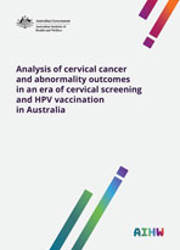Summary
This is the third report from an Australian-first project, combining screening, cancer, death, and HPV vaccination data to demonstrate the effects of screening and HPV vaccination on cervical cancer and precancerous abnormalities and to discern cervical screening behaviour.
Cervical cancers detected through cervical screening less likely to cause death
Cervical screening aims to detect and treat precancerous abnormalities that might otherwise progress to cervical cancer, and so cervical screening more frequently detects precancerous abnormalities than cervical cancer. This is reflected in the observation that most cervical cancers (more than 70%) occurred in women who had never screened or who were lapsed screeners (had not screened for some time).
Of the 6,897 cervical cancers diagnosed in women aged 20–69 in 2002–2012:
- 354 (5%) were detected through cervical screening
- 3,511 (51%) were diagnosed in women who had never screened.
The remaining 44% of cervical cancers were diagnosed in women who had screened prior to the cervical cancer diagnosis, but the cancer was not detected through cervical screening (25% were not detected through cervical screening but were diagnosed in women who had previously screened; 19% were interval cancers, diagnosed after a negative cervical screen).
Cervical cancers detected through cervical screening had a 77% lower risk of causing death before 31 December 2015 (the end of follow-up) than cervical cancers diagnosed in women who had never screened.
Greater survival benefits for women for whom the cancer was screen-detected is likely due to these cervical cancers being diagnosed at an earlier stage than cervical cancers diagnosed in women who had never screened.
Together these results indicate that it is beneficial to participate in cervical screening. Benefits are due to the detection of precancerous changes providing an opportunity for treatment prior to progression to cervical cancer, and to improved survival outcomes of cervical cancers that are detected through cervical screening due to these being diagnosed at an earlier stage.
HPV-vaccinated women less likely to have a high-grade abnormality
High-grade abnormalities, in particular precancerous abnormalities, are an important indicator of the effectiveness of HPV vaccination, since it is necessary for HPV vaccination to prevent these abnormalities if the long-term aim of preventing cervical cancer is to be realised.
Analyses showed that women vaccinated against HPV had a lower incidence of high-grade abnormalities than unvaccinated women.
- Incidence was 9 high-grade abnormalities per 1,000 HPV-vaccinated women compared with 13 high-grade abnormalities per 1,000 unvaccinated women.
- HPV-vaccinated women had a 41% lower risk of a high-grade abnormality than unvaccinated women.
Results were stronger when high-grade abnormalities were restricted to the precancerous abnormalities of cervical intraepithelial neoplasia (CIN) grade 3 and adenocarcinoma in situ (AIS).
- Incidence was 3 cases of CIN3 and/or AIS per 1,000 HPV-vaccinated women compared with 6 cases of CIN3 and/or AIS per 1,000 unvaccinated women.
- HPV-vaccinated women had a 57% lower risk of CIN3 and/or adenocarcinoma in situ than unvaccinated women.
As a final analysis, cervical cancer incidence rates were calculated for HPV-vaccinated and unvaccinated women. It was confirmed that sufficient time had not yet passed since the introduction of HPV vaccination in 2007 for cervical cancers diagnosed up to and including 2012 to show a clear effect of HPV vaccination on cervical cancer incidence.
HPV-vaccinated women more likely to participate in cervical screening
Women vaccinated against HPV had higher participation in cervical screening than unvaccinated women. Participation in 2013–2014 by HPV vaccination status showed that:
- for women aged 20–24, participation was 46% in HPV-vaccinated women and 33% in unvaccinated women
- for women aged 25–29, participation was 57% in HPV-vaccinated women and 44% in unvaccinated women
- participation in cervical screening increased with increasing number of vaccine doses received for both age groups 20–24 and 25–29.
Summary
1. Introduction
- Cancer screening programs in Australia
- Cervical screening reduces incidence of and mortality from cervical cancer
- Participation in cervical screening
- Cervical screening in an era of HPV vaccination
2. Objectives
- Premise of the broader data linkage project
- Objectives of the broader data linkage project
- Dissemination of findings from the broader data linkage project
3. Data and methods
- 3.1 Data sources for the broader data linkage project
- 3.2 Data flow and data linkage methods for the broader data linkage project
- 3.3 Methods used in this report
4. Cervical cancer outcomes
5. Cervical abnormality outcomes
6. Cervical screening behaviour
7. Discussion
Appendix A: Additional data tables
Appendix B: Positive predictive values of screening tests
Appendix C: Classifications
End matter: Acknowledgments; Abbreviations; Symbols; Glossary; References; List of tables; List of figures; List of boxes; Related publications



